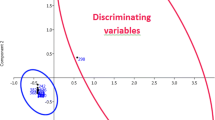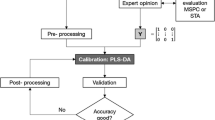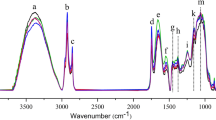Abstract
Adulteration of almond powder samples with apricot kernel was solved by gas chromatographic fatty acid fingerprinting combined with multivariate data analysis methods (principal component analysis (PCA), PCA-linear discriminant analysis (PCA-LDA), partial least squares (PLS), and LS support vector machine (LS-SVM). Different almond and apricot kernel samples were mixed at concentrations ranging from 10 to 90% w/w. PCA and PCA-LDA methods were applied for the classification of almonds, apricot kernels, and mixtures. PLS and LS-SVM were used for the quantification of adulteration ratios of almond. Models were developed using a training data set and evaluated using a validation data set. The root mean square error of prediction (RMSEP) and coefficient of determination (R 2) of validation data set obtained for PLS and LS-SVM were 5.01, 0.964 and 2.29, 0.995, respectively. The results showed that the methods can be applied as an effective and feasible method for testing almond adulteration.






Similar content being viewed by others
References
Alamprese C, Casale M, Sinelli N, Lanteri S, Casiraghi E (2013) Detection of minced beef adulteration with turkey meat by UV–vis, NIR and MIR spectroscopy. LWT-Food Sci Technol 53:225–232
Alonso JM, Kodad O, Gradziel TM (2012) Almond, in: fruit breeding, Springer pp 697–728
Arana V, Medina J, Alarcon R, Moreno E, Heintz L, Schäfer H, Wist J (2015) Coffee’s country of origin determined by NMR: the Colombian case. Food Chem 175:500–506
Chen H-F (2008) Computational study of histamine H 3-receptor antagonist with support vector machines and three dimension quantitative structure activity relationship methods. Anal Chim Acta 624:203–209
Custers D, Canfyn M, Courselle P, De Beer J, Apers S, Deconinck E (2014) Headspace–gas chromatographic fingerprints to discriminate and classify counterfeit medicines. Talanta 123:78–88
Deconinck E, De Leersnijder C, Custers D, Courselle P, De Beer J (2013) A strategy for the identification of plants in illegal pharmaceutical preparations and food supplements using chromatographic fingerprints. Anal Bioanal Chem 405:2341–2352
Destaillats FDR, Cruz-Hernandez C, Giuffrida F, Dionisi F (2010) Identification of the botanical origin of pine nuts found in food products by gas−liquid chromatography analysis of fatty acid profile. J Agric Food Chem 58:2082–2087
Ding X, Ni Y, Kokot S (2015) NIR spectroscopy and chemometrics for the discrimination of pure, powdered, purple sweet potatoes and their samples adulterated with the white sweet potato flour. Chemom Intell Lab Syst 144:17–23
Dourado F, Barros A, Mota M, Coimbra MA, Gama FM (2004) Anatomy and cell wall polysaccharides of almond (Prunus dulcis DA Webb) seeds. J Agric Food Chem 52:1364–1370
García-Reiriz A, Damiani PC, Culzoni MJ, Goicoechea HC, Olivieri AC (2008) A versatile strategy for achieving the second-order advantage when applying different artificial neural networks to non-linear second-order data: unfolded principal component analysis/residual bilinearization. Chemom Intell Lab Syst 92:61–70
Ge F, Chen C, Liu D, Zhao S (2014) Rapid quantitative determination of walnut oil adulteration with sunflower oil using fluorescence spectroscopy. Food Anal. Method 7:146–150
Geladi P, Kowalski BR (1986) Partial least-squares regression: a tutorial. Anal Chim Acta 185:1–17
Grob K, Rennhard S (1980) Evaluation of syringe handling techniques for injections into vaporizing GC injectors. J High Resolut Chromatogr 3:627–633
Hong X, Wang J, Qi G (2014) Comparison of spectral clustering, K-clustering and hierarchical clustering on e-nose datasets: application to the recognition of material freshness, adulteration levels and pretreatment approaches for tomato juices. Chemom Intell Lab Syst 133:17–24
Jiang S, Tan H, Guo C, Gong L, Shi F (2015) The development of an ultra-high performance liquid chromatography coupled to high resolution quadrupole-Orbitrap mass spectrometry method for the rapid detection and confirmation of illegal adulterated sedative-hypnotics in dietary supplements. Food Addit & Contam: Part A 32:1749–1759
Kang Y-W, Li J, Cao G-Y, Tu H-Y, Li J, Yang J (2008) Dynamic temperature modeling of an SOFC using least squares support vector machines. J Power Sources 179:683–692
Kim HJ, Lee JH, Park HJ, Kim J-Y, Cho S, Kim WS (2014) Determination of non-opioid analgesics in adulterated food and dietary supplements by LC-MS/MS. Food Addit & Contam: Part A 31:973–978
Kongbonga YGM, Ghalila H, Onana MB, Lakhdar ZB (2014) Classification of vegetable oils based on their concentration of saturated fatty acids using laser induced breakdown spectroscopy (LIBS). Food Chem 147:327–331
Kuś PM, van Ruth S (2015) Discrimination of polish unifloral honeys using overall PTR-MS and HPLC fingerprints combined with chemometrics. LWT-Food Sci. Technol. 62:69–75
Liu F, He Y, Wang L (2008a) Comparison of calibrations for the determination of soluble solids content and pH of rice vinegars using visible and short-wave near infrared spectroscopy. Anal Chim Acta 610:196–204
Liu F, He Y, Wang L (2008b) Determination of effective wavelengths for discrimination of fruit vinegars using near infrared spectroscopy and multivariate analysis. Anal Chim Acta 615:10–17
Martín Carratalá M, Garcia-Lopez C, Berenguer-Navarro V, Grané-Teruel N (1998) New contribution to the chemometric characterization of almond cultivars on the basis of their fatty acid profiles. J Agric Food Chem 46:963–967
Mendes TO, da Rocha RA, Porto BL, de Oliveira MA, dos Anjos VDC, Bell MJ (2015) Quantification of extra-virgin olive oil adulteration with soybean oil: a comparative study of NIR, MIR, and raman spectroscopy associated with chemometric approaches. Food Anal. Method 8:2339–2346
Moore JC, Spink J, Lipp M (2012) Development and application of a database of food ingredient fraud and economically motivated adulteration from 1980 to 2010. J Food Sci 77:R118–R126
Pan Y, Jiang J, Wang R, Cao H (2008) Advantages of support vector machine in QSPR studies for predicting auto-ignition temperatures of organic compounds. Chemom Intell Lab Syst 92:169–178
Paradkar M, Sakhamuri S, Irudayaraj J (2002) Comparison of FTIR, FT-Raman, and NIR spectroscopy in a maple syrup adulteration study. J Food Sci 67:2009–2015
Peng D, Bi Y, Ren X, Yang G, Sun S, Wang X (2015) Detection and quantification of adulteration of sesame oils with vegetable oils using gas chromatography and multivariate data analysis. Food Chem 188:415–421
Rebechi S, Vélez M, Vaira S, Perotti M (2016) Adulteration of Argentinean milk fats with animal fats: detection by fatty acids analysis and multivariate regression techniques. Food Chem 192:1025–1032
Rogozinski M (1964) A rapid quantitative esterification technique for carboxylic acids. J Chromatogr Sci 2:136–137
Rutkowska J, Bialek M, Adamska A, Zbikowska A (2015) Differentiation of geographical origin of cream products in Poland according to their fatty acid profile. Food Chem 178:26–31
Shin E-C, Craft BD, Pegg RB, Phillips RD, Eitenmiller RR (2010) Chemometric approach to fatty acid profiles in Runner-type peanut cultivars by principal component analysis (PCA). Food Chem 119:1262–1270
Smola AJ, Schölkopf B (2004) A tutorial on support vector regression. Stat Comput 14:199–222
Sun X, Lin W, Li X, Shen Q, Luo H (2015) Detection and quantification of extra virgin olive oil adulteration with edible oils by FT-IR spectroscopy and chemometrics. Anal Method 7:3939–3945
Tistaert C, Dejaegher B, Vander Heyden Y (2011) Chromatographic separation techniques and data handling methods for herbal fingerprints: a review. Anal Chim Acta 690:148–161
Torres-Moreno M, Torrescasana E, Salas-Salvadó J, Blanch C (2015) Nutritional composition and fatty acids profile in cocoa beans and chocolates with different geographical origin and processing conditions. Food Chem 166:125–132
Tres A, Ruiz-Samblas C, Van Der Veer G, Van Ruth S (2013) Geographical provenance of palm oil by fatty acid and volatile compound fingerprinting techniques. Food Chem 137:142–150
Troya F, Lerma-García M, Herrero-Martínez J, Simó-Alfonso E (2015) Classification of vegetable oils according to their botanical origin using n-alkane profiles established by GC–MS. Food Chem 167:36–39
Vapnik VN, Vapnik V (1998) Statistical learning theory. Wiley, New York
Varmuza K, Filzmoser P (2009) Introduction to multivariate statistical analysis in chemometrics. CRC Press, Boca Raton
Viaene J, Goodarzi M, Dejaegher B, Tistaert C, Le Tuan AH, Hoai NN, Van MC, Quetin-Leclercq J, Vander Heyden Y (2015) Discrimination and classification techniques applied on Mallotus and Phyllanthus high performance liquid chromatography fingerprints. Anal Chim Acta 877:41–50
Viana C, Zemolin GM, Müller LS, Dal Molin TR, Seiffert H, de Carvalho LM (2016) Liquid chromatographic determination of caffeine and adrenergic stimulants in food supplements sold in Brazilian e-commerce for weight loss and physical fitness. Food Addit & Contam: Part A 33:1–9
Zhong J, Qin X (2016) Rapid quantitative analysis of corn starch adulteration in Konjac Glucomannan by chemometrics-assisted FT-NIR spectroscopy. Food Anal Method 9:61–67
Zhou J, Yao L, Li Y, Chen L, Wu L, Zhao J (2014) Floral classification of honey using liquid chromatography–diode array detection–tandem mass spectrometry and chemometric analysis. Food Chem 145:941–949
Author information
Authors and Affiliations
Corresponding author
Ethics declarations
Funding
This study was funded by the University of Zanjan.
Conflict of Interest
Mahnaz Esteki declares that she has no conflict of interest.
Bahman Farajmand declares that he has no conflict of interest.
Yadollah Kolahderazi declares that he has no conflict of interest.
Jesus Simal-Gandara declares that he has no conflict of interest.
Ethical Approval
This article does not contain any studies with human participants or animals performed by any of the authors.
Informed Consent
Not applicable.
Rights and permissions
About this article
Cite this article
Esteki, M., Farajmand, B., Kolahderazi, Y. et al. Chromatographic Fingerprinting with Multivariate Data Analysis for Detection and Quantification of Apricot Kernel in Almond Powder. Food Anal. Methods 10, 3312–3320 (2017). https://doi.org/10.1007/s12161-017-0903-5
Received:
Accepted:
Published:
Issue Date:
DOI: https://doi.org/10.1007/s12161-017-0903-5




